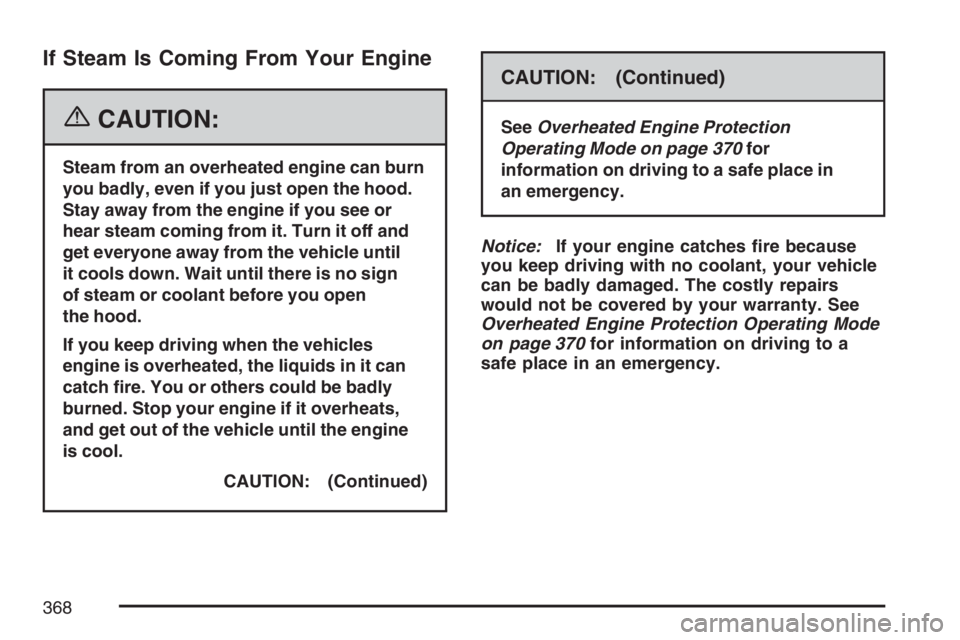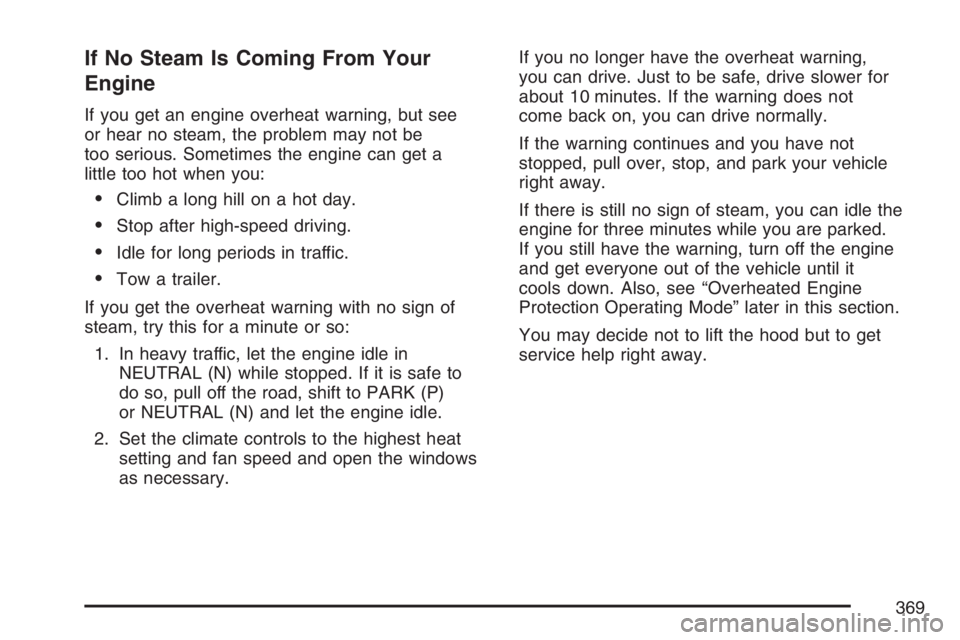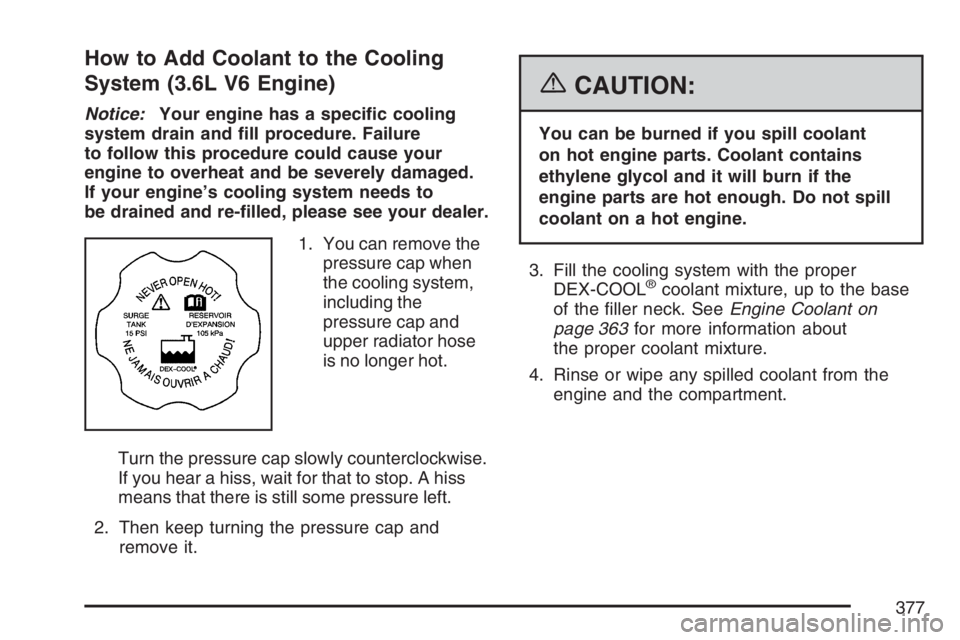Page 367 of 512
Radiator Pressure Cap
Notice:If the pressure cap is not tightly
installed, coolant loss and possible engine
damage may occur. Be sure the cap is properly
and tightly secured.
The radiator pressure cap is located in the front
of the engine compartment on the passenger’s
side of the vehicle. SeeEngine Compartment
Overview on page 350for more information
on location.
Engine Overheating
There is a coolant temperature gage and a
warning light on the instrument panel cluster that
indicate an overheated engine condition. See
Engine Coolant Temperature Gage on page 189
andEngine Coolant Temperature Warning Light
on page 188for more information.
In addition, if your vehicle is equipped with a
Driver Information Center (DIC), you will �nd an
ENGINE COOLANT HOT and a REDUCED
POWER STOP WHEN SAFE message displayed
on the DIC. SeeDIC Warnings and Messages
on page 208for more information.
367
Page 368 of 512

If Steam Is Coming From Your Engine
{CAUTION:
Steam from an overheated engine can burn
you badly, even if you just open the hood.
Stay away from the engine if you see or
hear steam coming from it. Turn it off and
get everyone away from the vehicle until
it cools down. Wait until there is no sign
of steam or coolant before you open
the hood.
If you keep driving when the vehicles
engine is overheated, the liquids in it can
catch �re. You or others could be badly
burned. Stop your engine if it overheats,
and get out of the vehicle until the engine
is cool.
CAUTION: (Continued)
CAUTION: (Continued)
SeeOverheated Engine Protection
Operating Mode on page 370for
information on driving to a safe place in
an emergency.
Notice:If your engine catches �re because
you keep driving with no coolant, your vehicle
can be badly damaged. The costly repairs
would not be covered by your warranty. See
Overheated Engine Protection Operating Mode
on page 370for information on driving to a
safe place in an emergency.
368
Page 369 of 512

If No Steam Is Coming From Your
Engine
If you get an engine overheat warning, but see
or hear no steam, the problem may not be
too serious. Sometimes the engine can get a
little too hot when you:
Climb a long hill on a hot day.
Stop after high-speed driving.
Idle for long periods in traffic.
Tow a trailer.
If you get the overheat warning with no sign of
steam, try this for a minute or so:
1. In heavy traffic, let the engine idle in
NEUTRAL (N) while stopped. If it is safe to
do so, pull off the road, shift to PARK (P)
or NEUTRAL (N) and let the engine idle.
2. Set the climate controls to the highest heat
setting and fan speed and open the windows
as necessary.If you no longer have the overheat warning,
you can drive. Just to be safe, drive slower for
about 10 minutes. If the warning does not
come back on, you can drive normally.
If the warning continues and you have not
stopped, pull over, stop, and park your vehicle
right away.
If there is still no sign of steam, you can idle the
engine for three minutes while you are parked.
If you still have the warning, turn off the engine
and get everyone out of the vehicle until it
cools down. Also, see “Overheated Engine
Protection Operating Mode” later in this section.
You may decide not to lift the hood but to get
service help right away.
369
Page 370 of 512

Overheated Engine Protection
Operating Mode
This emergency operating mode allows your
vehicle to be driven to a safe place in an emergency
situation. If an overheated engine condition exists,
an overheat protection mode which alternates �ring
groups of cylinders helps prevent engine damage.
In this mode, you will notice a signi�cant loss in
power and engine performance. The REDUCED
POWER STOP WHEN SAFE message will come
on in the Driver Information Center (DIC), if the
vehicle has one, along with the engine coolant
temperature warning light on the instrument panel,
to indicate the vehicle has entered overheated
engine protection operating mode. The temperature
gage will also indicate an overheat condition exists.
Driving extended miles (km) and/or towing a trailer
in the overheat protection mode should be avoided.
Notice:After driving in the overheated engine
protection operating mode, to avoid engine
damage, allow the engine to cool before
attempting any repair. The engine oil will
be severely degraded. Repair the cause of
coolant loss, change the oil and reset the
oil life system. SeeEngine Oil on page 353.
Cooling System
When you decide it is safe to lift the hood, this is
what you will see:
A. Coolant Recovery Tank
B. Radiator Pressure Cap
C. Electric Engine Cooling Fans
3.8L V6 Engine
370
Page 372 of 512

When the engine is cold, the coolant level should
be at or above the cold �ll line on the coolant
recovery tank. If it is not, there may be a leak at the
pressure cap or in the radiator hoses, heater hoses,
radiator, water pump, or somewhere else in the
cooling system.
{CAUTION:
Heater and radiator hoses, and other
engine parts, can be very hot. Do not
touch them. If you do, you can be burned.
Do not run the engine if there is a leak.
If you run the engine, it could lose all
coolant. That could cause an engine �re,
and you could be burned. Get any leak
�xed before you drive the vehicle.If there seems to be no leak, with the engine on,
check to see if the electric engine cooling fans
are running. If the engine is overheating, the fans
should be running. If the fans are not running,
the vehicle needs service.
Notice:Engine damage from running your
engine without coolant is not covered by your
warranty. SeeOverheated Engine Protection
Operating Mode on page 370for information
on driving to a safe place in an emergency.
Notice:Using coolant other than DEX-COOL®
may cause premature engine, heater core,
or radiator corrosion. In addition, the engine
coolant could require changing sooner, at
30,000 miles (50 000 km) or 24 months,
whichever occurs �rst. Any repairs would not
be covered by your warranty. Always use
DEX-COOL
®(silicate-free) coolant in your
vehicle.
372
Page 373 of 512

How to Add Coolant to the Coolant
Recovery Tank
{CAUTION:
Adding only plain water to your cooling
system can be dangerous. Plain water, or
some other liquid such as alcohol, can
boil before the proper coolant mixture will.
Your vehicle’s coolant warning system is
set for the proper coolant mixture. With
plain water or the wrong mixture, your
engine could get too hot but you would
not get the overheat warning. Your engine
could catch �re and you or others could
be burned. Use a 50/50 mixture of clean,
drinkable water and DEX-COOL
®coolant.If you have not found a problem yet, but the
coolant level is not at the cold �ll line, add a
50/50 mixture of clean, drinkable water and
DEX-COOL
®engine coolant at the coolant
recovery tank. SeeEngine Coolant on page 363
for more information.
Notice:In cold weather, water can freeze and
crack the engine, radiator, heater core and
other parts. Use the recommended coolant
and the proper coolant mixture.
{CAUTION:
You can be burned if you spill coolant
on hot engine parts. Coolant contains
ethylene glycol and it will burn if the
engine parts are hot enough. Do not spill
coolant on a hot engine.
When the coolant level in the coolant recovery
tank is at the cold �ll line, start the vehicle.
373
Page 374 of 512

If the overheat warning continues, there is one
more thing you can try. You can add the proper
coolant mixture directly to the cooling system
through the coolant �ll neck under the pressure cap,
but be sure the system is cool before you do it.
{CAUTION:
Steam and scalding liquids from a hot
cooling system can blow out and burn you
badly. They are under pressure, and if you
turn the radiator pressure cap — even a
little — they can come out at high speed.
Never turn the cap when the cooling
system, including the radiator pressure
cap, is hot. Wait for the cooling system
and radiator pressure cap to cool if you
ever have to turn the pressure cap.
How to Add Coolant to the Radiator
(3.8L V6 Engine)
Notice:Your engine has a speci�c radiator
�ll procedure. Failure to follow this procedure
could cause your engine to overheat and
be severely damaged.
1. You can remove the
radiator pressure
cap when the
cooling system,
including the radiator
pressure cap and
upper radiator hose,
is no longer hot.
Turn the pressure cap slowly counterclockwise
until it �rst stops. Do not press down while
turning the pressure cap. If you hear a
hiss, wait for that to stop. A hiss means there
is still some pressure left.
374
Page 377 of 512

How to Add Coolant to the Cooling
System (3.6L V6 Engine)
Notice:Your engine has a speci�c cooling
system drain and �ll procedure. Failure
to follow this procedure could cause your
engine to overheat and be severely damaged.
If your engine’s cooling system needs to
be drained and re-�lled, please see your dealer.
1. You can remove the
pressure cap when
the cooling system,
including the
pressure cap and
upper radiator hose
is no longer hot.
Turn the pressure cap slowly counterclockwise.
If you hear a hiss, wait for that to stop. A hiss
means that there is still some pressure left.
2. Then keep turning the pressure cap and
remove it.
{CAUTION:
You can be burned if you spill coolant
on hot engine parts. Coolant contains
ethylene glycol and it will burn if the
engine parts are hot enough. Do not spill
coolant on a hot engine.
3. Fill the cooling system with the proper
DEX-COOL
®coolant mixture, up to the base
of the �ller neck. SeeEngine Coolant on
page 363for more information about
the proper coolant mixture.
4. Rinse or wipe any spilled coolant from the
engine and the compartment.
377